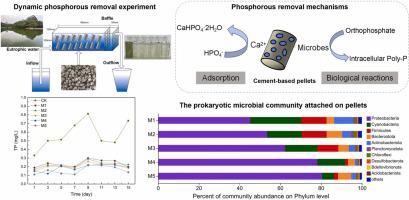当前位置:
X-MOL 学术
›
Environ. Technol. Innov.
›
论文详情
Our official English website, www.x-mol.net, welcomes your feedback! (Note: you will need to create a separate account there.)
Effect of cement-based composite pellets on phosphorus removal and microbial community structure in eutrophic water
Environmental Technology & Innovation ( IF 7.1 ) Pub Date : 2024-04-09 , DOI: 10.1016/j.eti.2024.103631 Yi Zhang , Benhong Liu , Lei Liu , Lixia You , Jue Wang , Rongting Xiang
Environmental Technology & Innovation ( IF 7.1 ) Pub Date : 2024-04-09 , DOI: 10.1016/j.eti.2024.103631 Yi Zhang , Benhong Liu , Lei Liu , Lixia You , Jue Wang , Rongting Xiang

|
Phosphorus (P) removal still faces challenges in eutrophic water treatment. Combining adsorption and biological reactions can efficiently reduce the P concentrations, achieving long-term function. In this study, five kinds of pellets were produced using cement, bentonite, and organic carbon (rice husk powder) with mass ratios of 100%:0%:0% (M1), 95%:5%:0% (M2), 92.5%:5%:2.5% (M3), 90%:5%:5% (M4), and 85%:5%:10% (M5) for phosphorus removal in eutrophic water. The static adsorption experiment revealed that both Langmuir and Freundlich models were suitable for describing the adsorption characteristics. The P-bonding energy (K) and adsorption capacity (K) followed the order of M1 < M2 < M3 < M4 < M5. The adsorption processes conformed to the Pseudo-second-order kinetic model. The adsorption capability of pellets decreased with increasing pH levels. The Cl, NO, and SO showed negligible effects on adsorption, while CO reduced the adsorption amount. In the dynamic experiment, all the pellets have sustained P removal efficiency with the average removal rates of 58.54% (M1), 60.78% (M2), 63.97% (M3), 66.81% (M4), and 72.05% (M5). The presence of CaHPO·2 HO in pellets after P removal indicated phosphate precipitation and ion exchange. The attached microbes in pellets exhibited an increase in abundance contributed to biological phosphorus removal and long-term effectiveness. Hence, this study introduces innovative cement-based pellets for phosphorus removal in eutrophic water, establishing a possibility for practical applications.
中文翻译:

水泥基复合颗粒对富营养化水体除磷及微生物群落结构的影响
富营养化水处理中磷(P)的去除仍然面临挑战。吸附与生物反应相结合,可有效降低P浓度,实现长期功能。本研究采用水泥、膨润土和有机碳(稻壳粉)生产五种颗粒,质量比分别为100%:0%:0%(M1)、95%:5%:0%(M2) 、 92.5%:5%:2.5% (M3)、90%:5%:5% (M4) 和 85%:5%:10% (M5) 用于富营养化水体除磷。静态吸附实验表明Langmuir和Freundlich模型都适合描述吸附特性。 P键能(K)和吸附容量(K)遵循M1 < M2 < M3 < M4 < M5的顺序。吸附过程符合准二级动力学模型。颗粒的吸附能力随着pH值的增加而降低。 Cl、NO和SO对吸附的影响可以忽略不计,而CO则降低了吸附量。动态实验中,所有颗粒均具有持续的磷去除效率,平均去除率分别为58.54%(M1)、60.78%(M2)、63.97%(M3)、66.81%(M4)和72.05%(M5)。除磷后球团中 CaHPO·2 H2O 的存在表明磷酸盐沉淀和离子交换。颗粒中附着的微生物丰度增加,有助于生物除磷和长期有效性。因此,本研究引入了用于富营养化水中除磷的创新水泥基颗粒,为实际应用奠定了可能性。
更新日期:2024-04-09
中文翻译:

水泥基复合颗粒对富营养化水体除磷及微生物群落结构的影响
富营养化水处理中磷(P)的去除仍然面临挑战。吸附与生物反应相结合,可有效降低P浓度,实现长期功能。本研究采用水泥、膨润土和有机碳(稻壳粉)生产五种颗粒,质量比分别为100%:0%:0%(M1)、95%:5%:0%(M2) 、 92.5%:5%:2.5% (M3)、90%:5%:5% (M4) 和 85%:5%:10% (M5) 用于富营养化水体除磷。静态吸附实验表明Langmuir和Freundlich模型都适合描述吸附特性。 P键能(K)和吸附容量(K)遵循M1 < M2 < M3 < M4 < M5的顺序。吸附过程符合准二级动力学模型。颗粒的吸附能力随着pH值的增加而降低。 Cl、NO和SO对吸附的影响可以忽略不计,而CO则降低了吸附量。动态实验中,所有颗粒均具有持续的磷去除效率,平均去除率分别为58.54%(M1)、60.78%(M2)、63.97%(M3)、66.81%(M4)和72.05%(M5)。除磷后球团中 CaHPO·2 H2O 的存在表明磷酸盐沉淀和离子交换。颗粒中附着的微生物丰度增加,有助于生物除磷和长期有效性。因此,本研究引入了用于富营养化水中除磷的创新水泥基颗粒,为实际应用奠定了可能性。



























 京公网安备 11010802027423号
京公网安备 11010802027423号